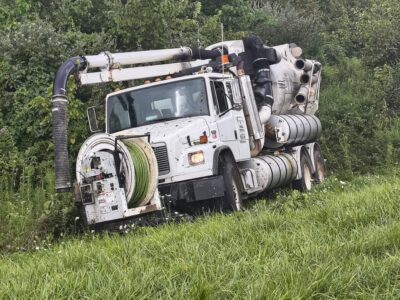35 years since the ‘Flood of Tears’

BURT Palmer, a Pipe Creek Road resident, stands inside his home, where he told The Times Leader on Wednesday about the deadly flooding that occurred there June 14, 1990.







SHADYSIDE — Denver Palmer was 22 years old and planning to watch a softball game on June 14, 1990. Instead, he spent the night helping his father and other area residents search the darkness for their neighbors who had been washed away by what many have called a “wall of water.”
Palmer wasn’t at home when the devastating flash flooding that claimed 26 lives along Wegee and Pipe creeks and Cumberland Run struck that evening. The softball game was rained out, so he stopped in Shadyside to get some pizza. That’s when he noticed the water in the parking lot was up to the bumper of his truck and knew that something wasn’t right. He didn’t know yet that a flash flood had destroyed much of the area.
As he tried to make his way back home, he discovered that the road to his house along Pipe Creek was completely gone.
Some sections had washed away entirely, and other parts were still submerged under several feet of water. He said he traveled over and around fallen trees and across waterlogged lawns in his effort to reach his home, passing vehicles that had been tossed about and overturned by the rushing water.
“It came up, and just as fast it went back down,” he said of the destructive deluge that is often called “The Flood of Tears” due to the loss of life it caused.
The Palmer family lived on the north side of Pipe Creek Road in the same house that his dad, Burt, still occupies today. Denver said the water never reached their house, but Burt noted that it turned his Buick around in the driveway.
It was a different story on the opposite side of the road, where Denver said a Methodist church, his grandparents’ mobile home and his uncle’s house and garage all were swept away. His uncle and family escaped and survived, but his grandparents did not.
“Pretty much everything on this side of the creek,” he said as he took a break from trimming grass on property he now owns on the south side of the road, just yards west of his childhood home.
After he arrived at home and assessed the situation, Denver set out to help with rescue and recovery efforts.
“I left here and went to Cumberland Run,” he said. “We searched for the Webb kids until 6 a.m. Later, they found them in the (Ohio) river in a tub.”
The children — Donald and Tiffany Webb — did not survive.
Although it has been 35 years since the deadly flooding occurred, Burt Palmer, now 82, still has vivid memories of what happened. He experienced both triumph and tragedy as he searched for the missing.
In one case, he found and was able to rescue a “stark naked” girl who was clinging to a tree. He got her down and carried her to safety, noting that in the heat of the moment, he punched a sheriff’s deputy who had failed to help her. Today, he still keeps a crystal award on his counter that he received for saving the child’s life.
“Burt Palmer — In appreciation for the heroic act you portrayed of risking your life to save another, on June 14, 1990, will never be forgotten,” it states.
The other people he found were not as fortunate as the young girl. Among them were his mother- and father-in-law, as well as Sue, Daniel and David Humphrey. In all, 12 residents of the Pipe Creek area perished.
The devastation was similar along Wegee Creek, where another 12 people were killed. Debris from demolished homes, vehicles, trees and more were strewn everywhere in the wake of the water.
The Palmers also talked about the aftermath of the flooding, when National Guard troops, law enforcement and local fire officials came in to help with rescue and then recovery efforts, as well as the cleanup. A curfew was implemented in the area, and for weeks residents were required to show identification and proof of residency every time they traveled to their homes. They said this was done to help prevent looting. They also needed tetanus shots and spent a lot of time at home because of travel restrictions in the area.
Denver said local, state and federal officials were not prepared to deal with the destruction.
“Nobody ever plans for that,” he said. “Just like a tornado. You can plan all you want, but one of these days …”
Despite living through the devastation, he added that he is comfortable living along the creek and isn’t afraid when it rains, but he does believe something similar eventually will happen again.
Officials at the time determined that the flooding was so intense due to extremely heavy rainfall and because debris that had collected in and around the streams piled up behind bridges and caused dams to form. The ground across Belmont County was already saturated from many consecutive days of rainfall.
“It seemed like it rained forever,” Denver recalled.
Then an additional 4 inches of rain fell on the Shadyside area in about two hours on June 14, 1990. When those dams of debris broke loose, all of the water they had trapped gushed downstream with incredible force.
You would never know such destruction occurred when looking at Wegee Creek today. On Thursday, that stream was running gently toward the Ohio River with tadpoles and small fish visible in the relatively calm water. Rocks that have been smoothed and rounded by the flow of the stream protruded from it, making it fairly easy to walk from one side to the other without getting wet.
With trees and vines forming a canopy overhead, the water in many places is only a few inches deep. One can easily wade through the water, which in a few spots becomes knee deep.
Many people live along Wegee Creek as it winds downhill from the Key Ridge and Jacobsburg area into the south end of Shadyside. The 1990 flood hasn’t deterred people from building homes and lives all along that stream.
Denver said Pipe Creek has changed over the past three decades, but people have allowed properties nearby to become cluttered with junk again. He noted that massive rocks that were placed on the southern stream bank to help stabilize it years ago have mostly washed away.
His father, now 82 years old, shares his belief that another major flood is inevitable, and he is afraid of what might happen.
“The last time the water came up in the field (across the road), I worried a lot,” he said. “It’s going to happen.”
Becky Horne, executive administrative assistant with the Belmont County Emergency Management Agency, said local authorities can’t take much action to maintain streambeds. She said the property owners along them actually own sections of the creeks, with the flowing water being a free commodity for them. She said those property owners can help prevent future disasters by making sure the streams and the surrounding land are not used for dump sites and by preventing tree limbs, vehicles, tires and other items from piling up.
In situations where illegal dumping occurs, she said people can contact the Belmont County Sheriff’s Department or JB Green Team, which work together with a special deputy who serves as a litter control officer. While they can’t enter people’s private property without permission or a legal document such as a warrant, they can provide resources and help to halt illegal dumping.
To reach the sheriff department, call 740-695-5124. For JB Green Team, go online to jbgreenteam.org.





